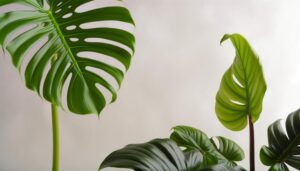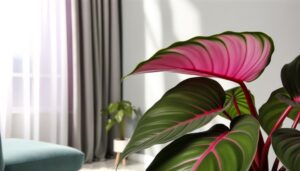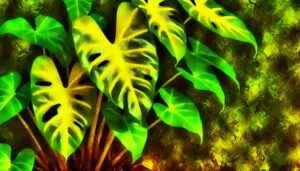What Is a Philodendron Selloum X Goeldii?
The Philodendron Selloum X Goeldii is a hybrid plant derived from the intentional crossbreeding of Philodendron bipinnatifidum and Philodendron goeldii, native to South America's tropical rainforests. It features deeply lobed, glossy, dark green leaves that can grow up to 90 cm in length.
The plant exhibits a sturdy, lignified stem with an upright growth pattern and semi-vining habit, supported by aerial roots. Best growing conditions include high humidity, indirect sunlight, and temperatures between 65-80°F (18-27°C).
Ideal soil is a well-aerated mix with peat moss, perlite, and pine bark, maintaining slight acidity for optimal growth. Familiarizing with these attributes reveals a more inclusive understanding.

Key Takeaways
- Hybrid plant from Philodendron bipinnatifidum and Philodendron goeldii, originating in South America.
- Features deeply lobed, pinnate leaves up to 90 cm long, with glossy, dark green foliage.
- Requires high humidity, indirect sunlight, and temperatures between 65-80°F (18-27°C) for optimal growth.
- Thrives in well-aerated soil mix of peat moss, perlite, and pine bark with slightly acidic pH.
- Propagates through stem cuttings and air layering, ensuring proper environmental conditions for successful growth.
Origins and History

The Philodendron Selloum x Goeldii, a hybrid of the Philodendron bipinnatifidum and Philodendron goeldii species, traces its origins to the tropical rainforests of South America, particularly in regions of Brazil and surrounding countries.
This hybrid is a product of intentional crossbreeding efforts aimed at enhancing specific desirable traits such as adaptability to various light conditions and improved foliage aesthetics.
The natural habitats of its parent species are characterized by high humidity, consistent rainfall, and rich, well-draining soils, conditions that have notably influenced the plant's cultivation requirements.
The hybridization process has been instrumental in expanding the genetic diversity within the Philodendron genus, offering horticulturists and plant enthusiasts a robust, versatile specimen for both ornamental and research purposes.
Physical Characteristics
The Philodendron Selloum X Goeldii exhibits distinct morphological characteristics, particularly its deeply lobed, pinnatifid leaves that can reach substantial dimensions, often exceeding 60 cm in length.
The plant's robust, erect stems support its vigorous growth pattern, characterized by a tendency to produce multiple offshoots.
These structural features contribute to its considerable aesthetic and horticultural appeal.
Leaf Shape and Size
Characterized by their deeply lobed, pinnate leaves, Philodendron Selloum X Goeldii exhibits significant variation in leaf shape and size, which can range from compact and narrow to broad and expansive forms.
The foliage typically emerges with a glossy, dark green hue, contributing to its ornamental appeal. Individual leaves can measure up to 90 centimeters in length and 60 centimeters in width, displaying a complex arrangement of leaflets.
The lobes are often deeply incised, creating a feathery appearance that enhances the plant's aesthetic complexity. This morphological diversity not only aids in maximizing photosynthetic efficiency but also provides adaptability to various environmental conditions, thereby making it a robust choice for both indoor and outdoor horticultural applications.
Stem and Growth Pattern
In addition to its stunning foliage, Philodendron Selloum X Goeldii features a strong and sturdy stem structure that supports its extensive leaf development. The stem is typically thick and lignified, providing crucial mechanical support for the plant's expansive canopy.
Nodes along the stem are well-defined, aiding the growth of adventitious roots and new shoots. This hybrid demonstrates a primarily upright growth pattern, though it can exhibit a semi-vining habit under ideal conditions. Internodal spacing is relatively short, contributing to a compact and dense appearance.
The plant's ability to produce aerial roots further enhances its stability and nutrient uptake, making it adaptable to various environmental settings. Overall, the stem morphology is essential to the plant's resilience and ornamental appeal.
Ideal Growing Conditions
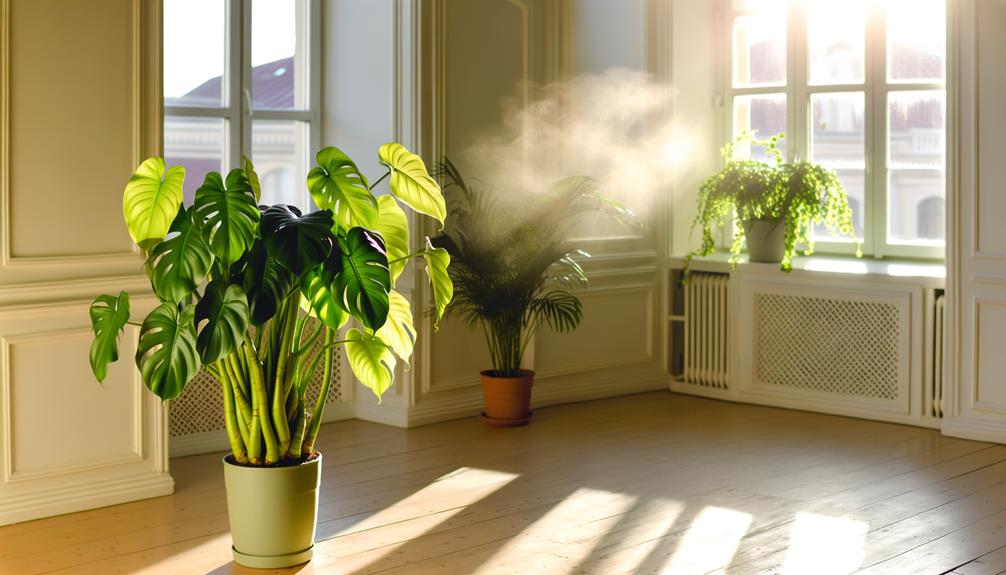
Optimal growing conditions for Philodendron Selloum X Goeldii necessitate consistently high humidity levels, indirect sunlight, and well-draining soil. This hybrid thrives in environments that mimic its native tropical habitat. Maintaining ideal conditions promotes vigorous growth and healthy foliage.
- Humidity: Aim for 60-80% relative humidity to prevent leaf desiccation and promote lush growth.
- Light: Provide bright, indirect light to avoid leaf scorching while ensuring adequate photosynthesis.
- Temperature: Maintain ambient temperatures between 65-80°F (18-27°C) to facilitate metabolic processes and growth.
- Watering: Keep the soil evenly moist but not waterlogged to prevent root rot and promote nutrient uptake.
- Air Circulation: Ensure good air circulation to reduce the risk of fungal diseases and enhance transpiration.
These parameters are essential for cultivating an thriving Philodendron Selloum X Goeldii.
Soil and Potting Mix
To support the ideal growing conditions for Philodendron Selloum X Goeldii, selecting the appropriate soil and potting mix is essential for ensuring proper drainage and aeration.
This hybrid thrives in a well-aerated, loose substrate that allows roots to breathe while retaining adequate moisture. A recommended composition includes a blend of peat moss, perlite, and pine bark. Peat moss provides essential organic matter and retains moisture, while perlite enhances drainage by creating air pockets. Pine bark adds structural integrity and further improves aeration.
Additionally, incorporating horticultural charcoal can mitigate risks of root rot by absorbing excess moisture. Ensuring the soil pH remains slightly acidic, ideally between 5.5 and 6.5, optimizes nutrient uptake and promotes robust growth.
Watering Needs
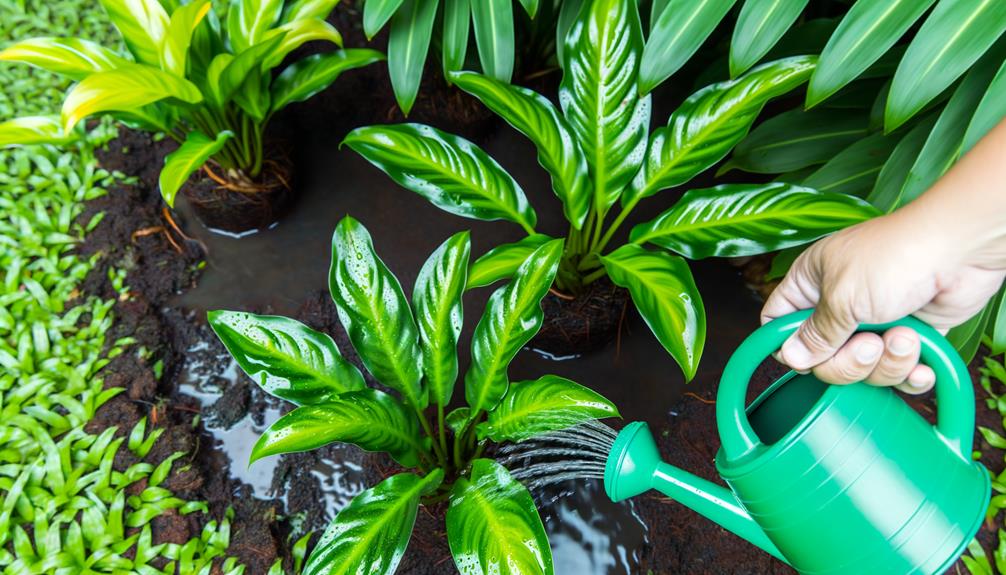
Proper watering is essential for the health of Philodendron Selloum X Goeldii, requiring a balance between maintaining soil moisture and preventing waterlogging. This hybrid species thrives in well-draining soil that is consistently moist but not saturated. Overwatering can lead to root rot, while underwatering may cause leaf browning and wilting.
Watering Frequency: Water when the top 2 inches of soil feel dry to the touch.
Water Quality: Use distilled or rainwater to avoid the buildup of salts and minerals.
Drainage: Ensure the pot has sufficient drainage holes to prevent water stagnation.
Humidity: Maintain ambient humidity levels between 60-80% to mimic tropical conditions.
Seasonal Adjustments: Reduce watering frequency during the plant's dormancy period in winter.
Adhering to these guidelines promotes prime plant health.
Light Requirements
Philodendron Selloum X Goeldii thrives in bright, indirect light, which promotes excellent photosynthesis and growth without causing leaf burn. This hybrid species benefits from light intensities ranging between 10,000 to 20,000 lux.
Excessive direct sunlight can result in photodamage, characterized by chlorosis and necrosis of the foliage. Conversely, insufficient light conditions may lead to etiolation, manifesting as elongated stems and reduced leaf size.
For ideal growth, it is advisable to place the plant near east or north-facing windows, where it can receive adequate luminance without harsh exposure. Artificial grow lights with a balanced spectrum can also be employed to supplement natural light, ensuring the plant's photoperiodicity aligns with its physiological requirements.
Regular monitoring and adjustment of light conditions are essential for maintaining plant health.
Fertilizing Tips
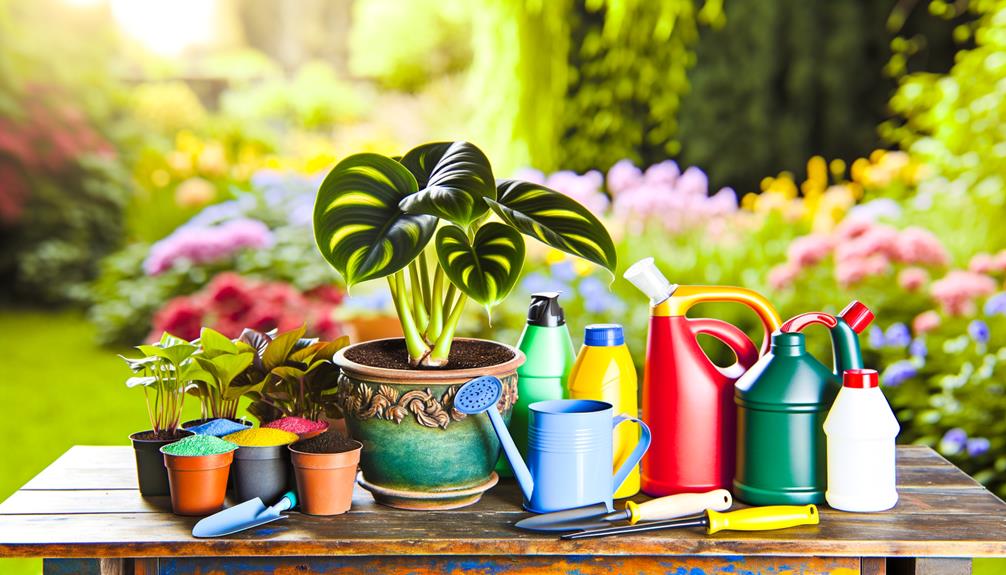
For best growth, Philodendron Selloum X Goeldii benefits from a balanced, water-soluble fertilizer with a 20-20-20 NPK ratio.
During the active growing season, typically from spring to early autumn, a bi-weekly feeding schedule is recommended to guarantee adequate nutrient availability.
Conversely, reduce fertilization frequency to once a month during the plant's dormant period in winter to avoid nutrient overload and root burn.
Optimal Fertilizer Types
Choosing the right fertilizer for Philodendron Selloum X Goeldii is crucial to promoting ideal nutrient absorption and strong growth. This hybrid requires a balanced nutrient profile to thrive, especially concerning macronutrients and micronutrients.
- Balanced N-P-K Ratio: Opt for fertilizers with a balanced Nitrogen (N), Phosphorus (P), and Potassium (K) ratio such as 10-10-10 or 20-20-20.
- Micronutrient Inclusion: Ensure the fertilizer includes essential micronutrients like iron, magnesium, and manganese.
- Slow-Release Formulas: Choose slow-release fertilizers for continuous nutrient availability.
- Liquid Fertilizers: Apply liquid fertilizers for faster nutrient uptake during the growing season.
- Organic Options: Consider organic fertilizers to enhance soil health and structure, offering a consistent nutrient release.
These guidelines will support vigorous growth and lush foliage.
Seasonal Feeding Schedule
Understanding the seasonal feeding schedule is essential to guarantee the Philodendron Selloum X Goeldii receives the appropriate nutrients during its active and dormant phases.
During the growing season, typically spring and summer, a balanced liquid fertilizer with a 20-20-20 NPK ratio should be applied bi-weekly to promote robust growth and development.
In contrast, the dormant season, encompassing autumn and winter, necessitates a significant reduction in feeding frequency to once every six to eight weeks, utilizing a diluted solution to prevent nutrient build-up and root burn.
Monitoring plant response and adjusting the schedule accordingly ensures peak health and vigor, fostering a thriving environment for this hybrid species.
Proper fertilization aligns with the plant's metabolic demands, enhancing its overall well-being.
Pruning and Maintenance
Proper trimming and maintenance of Philodendron Selloum X Goeldii involve the systematic removal of dead or damaged leaves and stems to promote ideal growth and overall plant health. This process not only enhances the plant's aesthetic appeal but also mitigates the risk of disease propagation. Utilize sterilized cutting tools to guarantee a clean cut and minimize potential infection vectors. Regular inspection and timely intervention are essential.
- Eliminate yellow or brown foliage: These are typically non-functional and may harbor pathogens.
- Prune leggy growth: Encourages denser, more compact growth.
- Sanitize tools: Prevents cross-contamination between plants.
- Trim during the growing season: Enhances recovery and regrowth rate.
- Monitor for new growth: Ensures pruning effectiveness and overall plant vitality.
Common Pests and Diseases
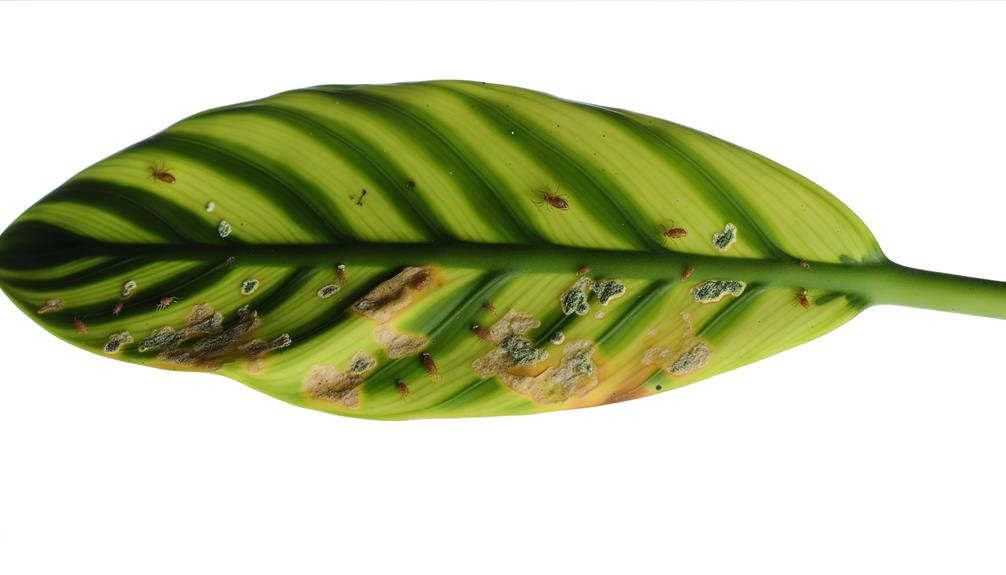
Philodendron Selloum X Goeldii is susceptible to common insect infestations such as spider mites, aphids, and mealybugs, which can cause significant damage to the foliage.
Additionally, this hybrid may experience fungal infections characterized by symptoms including leaf spots, yellowing, and wilting.
Effective treatment methods encompass both mechanical removal and the application of appropriate insecticides and fungicides to manage and mitigate these issues.
Common Insect Infestations
Aphids, spider mites, and mealybugs are among the most common insect infestations that can adversely affect the health and growth of Philodendron Selloum x Goeldii. These pests can cause significant damage by sucking plant sap, leading to weakened growth, yellowing leaves, and potential disease transmission. Effective identification and management are essential for maintaining plant vitality.
Common insect infestations include:
- Aphids: Small, soft-bodied insects that can cluster on new growth and excrete honeydew, attracting sooty mold.
- Spider Mites: Minute arachnids that cause stippling and webbing on leaves.
- Mealybugs: White, cottony pests that excrete honeydew and can stunt growth.
- Scale Insects: Hard-shelled pests that adhere to stems and leaves.
- Whiteflies: Tiny, winged insects that cause leaf yellowing and curling.
Understanding these pests is necessary for effective control.
Fungal Infections Symptoms
Frequently, fungal infections manifest in Philodendron Selloum x Goeldii through symptomatic signs such as leaf spots, wilting, and root rot, requiring prompt identification and intervention to prevent extensive damage.
Leaf spots often appear as irregular, necrotic patches, varying in color from yellow to brown. Wilting can occur due to compromised vascular tissues, hindering water transport. Root rot, caused by pathogens like Pythium and Phytophthora, leads to decayed, mushy roots, resulting in plant instability and nutrient uptake issues.
Additionally, fungal spores can proliferate in humid, poorly ventilated conditions, worsening the infection. Early detection is essential to mitigate the spread and severity of these symptoms, ensuring the health and longevity of the Philodendron Selloum x Goeldii.
Effective Treatment Methods
Implementing successful treatment methods for common pests and diseases in Philodendron Selloum x Goeldii requires a thorough understanding of both chemical and non-chemical control strategies to promote ideal plant health. Effective measures include:
- Mechanical Removal: Manually removing pests such as aphids and spider mites to minimize infestation.
- Biological Control: Utilizing beneficial insects like ladybugs and predatory mites to naturally reduce pest populations.
- Chemical Treatments: Applying systemic insecticides and fungicides, ensuring accurate dosages and adherence to safety guidelines.
- Cultural Practices: Enhancing air circulation, maintaining proper watering schedules, and ensuring adequate light to prevent disease proliferation.
- Sanitation: Regularly cleaning tools and removing dead or diseased plant material to prevent pathogen spread.
These methods, when combined, create a robust defense against common phytopathogens and pests.
Propagation Methods
Propagation of Philodendron Selloum X Goeldii can be effectively achieved through both stem cuttings and air layering. Each method offers unique advantages for successful plant multiplication.
For stem cuttings, select a healthy section of the stem with at least two nodes and remove lower leaves. Place the cutting in a well-draining, sterile potting mix, maintaining high humidity and indirect light for best rooting.
Air layering involves making an incision on a mature stem, dusting with rooting hormone, and wrapping with moist sphagnum moss and plastic. This method promotes root development while still attached to the parent plant.
Both techniques require careful attention to environmental conditions to ensure successful propagation and growth of new plants.
Conclusion
To sum up, the Philodendron selloum x goeldii, a botanical wonder, requires careful attention, similar to a symphony needing accurate coordination.
Its distinct physical traits and particular growth requirements call for a balanced method in soil composition, watering, and fertilization.
Consistent trimming and diligent pest control also guarantee its best growth.
Proper propagation methods, when skillfully carried out, enable the perpetuation of this extraordinary hybrid.
Proficiency in its cultivation ultimately results in a visually engaging and botanically important specimen.


